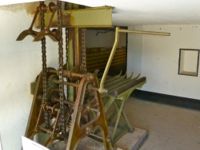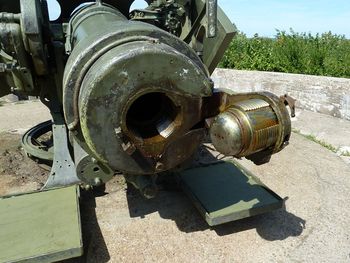Battery Gunnison
| More information at Warlike, Wikidata, Wikipedia
Endicott Period Part of the Harbor Defense of Southern New York. Originally built as an Endicott Period concrete coastal gun battery with two 6" M1903 guns mounted on M1903 disappearing carriages. This was a two-story gun battery with the guns located on the upper level and the central magazine (separate shell and powder rooms) located on the lower level. Manual Hodges shell hoists were provided to move the ammunition from the lower level to the gun loading platform. Gun #2 shell hoist is shown in the photograph and was restored to operational condition for interpretation by the Army Ground Forces Association in 2005.

World War IThe U.S. entry into World War I resulted in a widespread removal of large caliber coastal defense gun tubes for service in Europe. Many of the gun and mortar tubes removed were sent to arsenals for modification and mounting on mobile carriages, both wheeled and railroad. Most of the removed gun tubes never made it to Europe and were either remounted or remained at the arsenals until needed elsewhere. The guns of Battery Gunnison were not affected by the World War I redistribution or the following 1920 disarmament program. World War II The gun tubes were removed and transferred back to Watervliet on 10 may 1943 and the carriages were salvaged on 19 Apr 1943. The empty battery was then modified by filling in and raising the gun platforms to accommodate the two M1900 6" guns and Barbette carriages from Battery Peck. A new plotting room was built into the back of the central magazine replacing two utility rooms. The modifications to the battery cost an additional $ 28,747.64. The modernized battery was designated as New Battery Peck and functioned as an examination battery for ships entering New York Harbor. The examination battery fired warning shots over ships that failed to respond to challenges by the Harbor Entrance Command Post (HECP) atop Battery Potter. If an errant ship failed to respond to the warning shots, Battery Gunnison was capable of destructive fire on those ships. Sand filled warning shots were fired on 12 occasions. Destructive fire was authorized on two occasions but the ships halted as soon as it started. Battery Gunnison maintained this role through the end of World War II.
Current StatusPart of the Gateway National Recreation Area, Sandy Hook - The Fort Hancock Sandy Hook Proving Ground National Historic Landmark, New Jersey. Two 6" M1900 guns on M1900 carriages in place. Gun #1 and Gun #2 have operating breech blocks and elevation. Gun #1 has operating traverse. The plotting room has been fitted out to recreate the look and the equipment of the World War II plotting room with much of the equipment operational. This restoration work was performed in partnership with the National Park Service by the Army Ground Forces Association (AGFA). Restoration work and interpretive programming continue. See "http://www.arnygroundforces.org/" for additional information and articles on restoration/interpretation progress.
Recent Blog Posts: Sources: Links: Visited: 14 Aug 2010 Picture Gallery
| |||||||||||||||||||||||||||||||||||||||||||||||||||||||||||||||||||||||||||||||||||||||
- 6" Rifle M1903
- 6" Rifle Battery
- 6" Rifle M1900
- Visited
- All
- New Jersey All
- New Jersey Battery
- New Jersey Monmouth County
- Battery Gunnison
- National Recreation Area
- Endicott Period Battery
- Coastal Battery
- Fort Hancock (2)
- Harbor Defense of Southern New York
- 1942 Scrapping
- Display Gun
- 2010 Northern Trip
- Must See
- Starter Page







